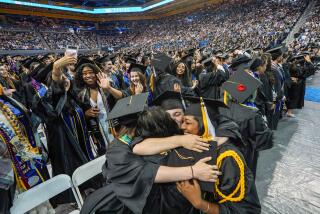Clinton’s Student Aid Plan Is Graded Down by Lenders
WASHINGTON — At first blush, the idea sounds reasonable enough. Who would object to a plan to save the country money and help more students through college by revamping the national student loan program?
The Administration proposes that the loans be made directly by the government through the Education Department. At present they are offered by private financial institutions and guaranteed by the government.
But opposition to the proposal is mounting, both from lawmakers and the private lenders.
Word on Capitol Hill is that President Clinton will have to fight if he wants to adopt his system of direct student loans. Eighty representatives of banks and other special interest groups participated in a lobbying day Tuesday and knocked on doors of senators and congressmen to call attention to what they see as the potential problems of direct lending.
THE PLAN: The Administration would radically overhaul the loan system that millions of students at colleges, universities and trade schools use to pay for their education. The proposal is part of a larger goal of providing college educations for more students.
By 1997, if the plan is approved, students who qualify for loans would get them directly from the government, rather than through one of almost 8,000 private lenders that now provide government-guaranteed loans.
Under one option, the Internal Revenue Service would play a role in collecting payments on loans, theoretically making it more difficult for loan recipients to escape repayment.
THE DEBATE: A General Accounting Office study touted by the Administration contends that by switching to a direct government loan program, the government could save $4.8 billion over the first five years.
“The big benefit of this is that we can reduce the deficit by simplifying this system,” said Maureen Mclaughlin, acting assistant secretary for post-secondary education.
The Administration argues that report after report has found the current system poorly managed, inefficient and derelict in collecting back loans.
In addition, concerns are rising about hefty profit margins for private lenders. Among them is the Student Loan Marketing Assn., known as Sallie Mae. This private corporation chartered by Congress had a profit of nearly $400 million last year, and a recent GAO study disclosed its president’s annual compensation package was $2.1 million.
Sen. Paul Simon (D-Ill.) said Tuesday that the current system amounts to “a welfare system for Sallie Mae and a welfare system for the banks.”
But Susan Hattan, minority staff director on the Senate Committee on Labor and Human Resources, said many Republicans and even some Democrats have “very, very serious concerns” about whether a direct government loan program will work.
The banks that handle guaranteed student loans argue that the Administration’s claims that a direct loan program would save money are unsubstantiated and do not take into consideration the costs of dismantling existing programs, additional costs to schools or potential costs for management problems and waste and fraud.
Opponents’ arguments were bolstered by a recent report by the Library of Congress’ Congressional Research Service. It said that while the existing system is “inefficient” it “cannot be fixed by simple conversion to a direct loan program, however inviting such a proposal might appear.”
OUTLOOK: Banks and other businesses that have a stake in preserving the existing system--which generated 4.8 million new loans totaling more than $13 billion in 1991 alone--will wage a fierce fight to block the move. They will try to persuade colleges that the Administration’s plan would mean more paperwork for schools.
“It’s no coincidence that they’re not in favor of change,” said Peter Magrath, president of the National Assn. of State Universities and Land Grant Colleges, who favors the Administration’s program. “The current system gives them steady income.”
More to Read
Sign up for Essential California
The most important California stories and recommendations in your inbox every morning.
You may occasionally receive promotional content from the Los Angeles Times.










